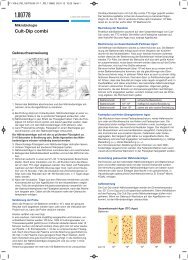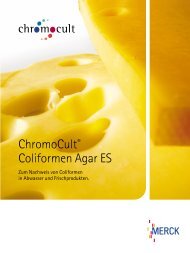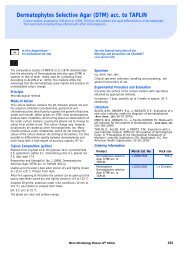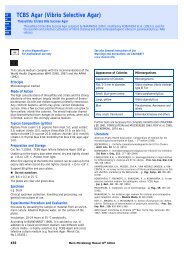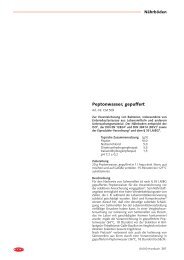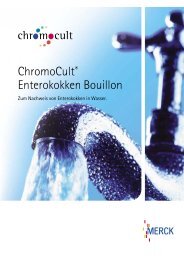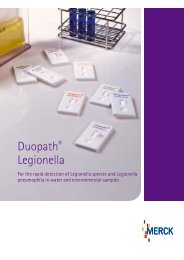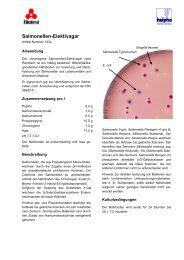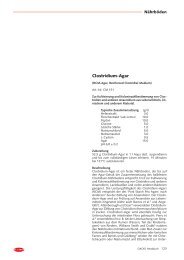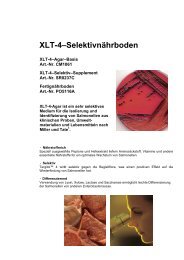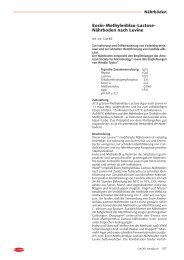Urea Agar Base (7226) - mibius
Urea Agar Base (7226) - mibius
Urea Agar Base (7226) - mibius
You also want an ePaper? Increase the reach of your titles
YUMPU automatically turns print PDFs into web optimized ePapers that Google loves.
UREA AGAR BASE (<strong>7226</strong>)Intended Use<strong>Urea</strong> <strong>Agar</strong> <strong>Base</strong> is used for the differentiation of microorganisms on the basis of urease production.Product Summary and ExplanationChristensen devised a urea agar medium containing peptone and dextrose that had a reduced buffer content. 1 Themedium supported a vigorous growth of many Gram-negative, enteric bacilli and readily permitted observation of ureaseproduction. Ewing used <strong>Urea</strong> <strong>Agar</strong> <strong>Base</strong> as a differential medium in the examination of many cultures from stoolspecimens. 2 <strong>Urea</strong> <strong>Agar</strong> <strong>Base</strong> may be used as a screening medium (along with Triple Sugar Iron <strong>Agar</strong>) for the selection ofSalmonella and Shigella cultures for serologic classification. 3 <strong>Urea</strong> <strong>Agar</strong> <strong>Base</strong> is used to detect production of urease byyeast. 4 <strong>Urea</strong>se production is an important differential test in microbiology and outlined in standard methods. 5-7Principles of the ProcedureEnzymatic Digest of Gelatin provides nitrogen, carbon, and amino acids required for organism growth in <strong>Urea</strong> <strong>Agar</strong> <strong>Base</strong>.Dextrose is an energy source. Sodium Chloride maintains the osmotic balance of the medium. MonopotassiumPhosphate is the buffer. <strong>Urea</strong> provides a nitrogen source for organisms producing urease. The splitting of urea by ureasecauses the release of ammonia, increasing pH of the medium to the alkaline side. This is indicated by a color change ofthe pH indicator, Phenol Red, from yellow (pH 6.8) to red (pH 8.1). <strong>Agar</strong> is added as a supplement to solidify the medium.Formula / LiterSupplementEnzymatic Digest of Gelatin......................................................1 g <strong>Agar</strong>, Bacteriological 15 gDextrose....................................................................................1 gSodium Chloride........................................................................5 gMonopotassium Phosphate ......................................................2 g<strong>Urea</strong>.........................................................................................20 gPhenol Red ........................................................................0.012 gFinal pH: 6.8 ± 0.2 at 25°CFormula may be adjusted and/or supplemented as required to meet performance specifications.Precautions1. For Laboratory Use.2. HARMFUL. Harmful if swallowed, inhaled, or absorbed through the skin. Irritating to skin, respiratory tract, and eyes.Directions1. Suspend 29 g of the medium in 100 mL of purified water until dissolved completely. Filter sterilize.2. Suspend 15 g of agar in 900 mL of purified water.3. Heat with frequent agitation and boil for one minute to completely dissolve the medium.4. Autoclave at 121°C for 15 minutes.5. Cool sterilized agar to 45 - 50°C and aseptically add the sterile <strong>Urea</strong> <strong>Agar</strong> <strong>Base</strong>.6. Mix thoroughly and dispense into sterile tubes. Place tubes in a slanted position.Quality Control SpecificationsDehydrated Appearance: Powder is homogeneous, free flowing, and off-white.Prepared Appearance: Prepared medium is light to medium yellow-orange and trace to slight hazy.Expected Cultural Response: Cultural response on <strong>Urea</strong> <strong>Agar</strong> <strong>Base</strong> supplemented with agar at 35°C after 18 - 24 hoursincubation.MicroorganismEscherichia coli ATCC® 25922Klebsiella pneumoniae ATCC® 13883Proteus vulgaris ATCC® 13315Salmonella typhimurium ATCC® 14028The organisms listed are the minimum that should be used for quality control testing.Reactionsnegativeweak positivepositivenegativePI <strong>7226</strong>, Rev 03, 11/21/04
Test Procedure1. Use a heavy inoculum from a pure 18 – 24 hour culture. Inoculate by streaking back and forth over the entire slantsurface. Do not stab the butt because it serves as a color control.2. Incubate tubes with loose caps at 35 ± 2°C.3. Observe reactions after 6 and 24 hours, and for the next 6 days. 1 Longer periods of incubation may be necessary.ResultsThe production of urease is a positive reaction, indicated by an intense red or pink color on the slant.No color change of the medium is a negative reaction.StorageStore sealed bottle containing the dehydrated medium at 2 - 8°C. Once opened and recapped, place container in a lowhumidity environment at the same storage temperature. Protect from moisture and light by keeping container tightlyclosed.ExpirationRefer to expiration date stamped on the container. The dehydrated medium should be discarded if not free flowing, or ifappearance has changed from the original color. Expiry applies to medium in its intact container when stored as directed.Limitations of the Procedure1. The alkaline reaction produced in this medium after prolonged incubation may not be caused by urease activity. Falsepositive reactions may occur due to the utilization of peptones or other proteins that raise the pH due to proteinhydrolysis and the release of excessive amino acid residues. To eliminate possible protein hydrolysis, perform acontrol test with the same test medium without urea. Do not autoclave medium because excessive heat may alteringredients. 82. Do not heat or reheat the medium because urea decomposes very easily.3. Due to nutritional variation, some strains may be encountered that grow poorly or fail to grow on this medium. <strong>Urea</strong><strong>Agar</strong> <strong>Base</strong> detects rapid urease activity of only the urease-positive Proteus spp.Packaging<strong>Urea</strong> <strong>Agar</strong> <strong>Base</strong> Code No. <strong>7226</strong>A 500 g<strong>7226</strong>B 2 kg<strong>7226</strong>C 10 kgReferences1. Christensen, W. B. 1946. <strong>Urea</strong> decomposition as a means of differentiating Proteus and paracolon cultures from each other and from Salmonellaand Shigella types. J. Bacteriol. 52:461.2. Ewing, W. H. 1946. An additional Shigella paradysenteriae serotype. J. Bacteriol. 51:433-445.3. Ewing, W. H., and D. W. Bruner. 1947. Selection of Salmonella and Shigella cultures for serological classification. Am. J. Clin. Pathol. 17:1-12.4. Baron, E. J., L. R. Peterson, and S. M. Finegold. 1994. Bailey & Scott’s Diagnostic Microbiology, 9 th ed. Mosby-Year Book, Inc., St. Louis, MO.5. Vanderzant, C., and D. F. Splittstoesser (eds.). 1992. Compendium of methods for the microbiological examination of foods, 3 rd ed. AmericanPublic Health Association, Washington, D.C.6. Andrews, W. H., G. A. June, P. S. Sherrod, T. S. Hammack, and R. M. Amaguana. 1995. FDA Bacteriological analytical manual, 8 th ed. AOACInternational, Gaithersburg, MD.7. Marshall, R. T. (ed.). 1993. Standard methods for the examination of dairy products. 16 th ed. American Public Health Association, Washington,D.C.8. MacFaddin, J. F. 1985. Media for isolation-cultivation-identification-maintenance of medical bacteria. Williams & Wilkins, Baltimore, MD.Technical InformationContact Acumedia Manufacturers, Inc. for Technical Service or questions involving dehydrated culture media preparation or performance at (517)372-9200 or fax us at (517)372-2006.PI <strong>7226</strong>, Rev 03, 11/21/04



